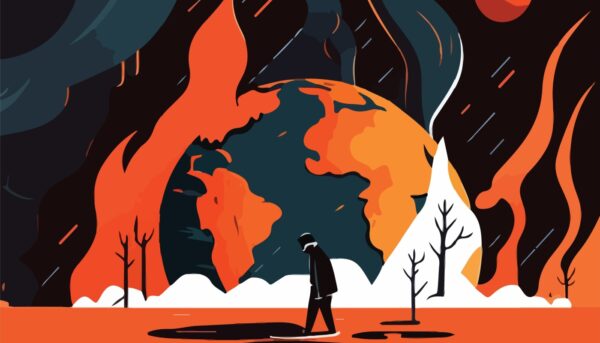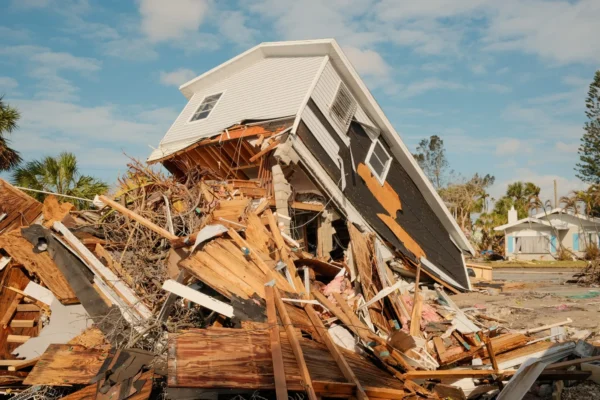Last month, as Hurricane Milton barreled toward Florida, social media was flooded with disturbing images: ominously swirling dark clouds, completely flooded streets, and captions warning of the “apocalypse”. On TikTok, in particular, the natural disaster became a breeding ground for videos showing the storm’s devastation, set to spooky music or spiced up with dramatic sound effects. While Hurricane Milton was undoubtedly an extremely powerful and dangerous storm and living proof of global warming happening right in front of our eyes, what unfolded on social media was something else – a digital storm of exaggerated panic, fear, and, in some cases, outright fake news.
As I scrolled through my feed, too long as usual, what struck me most wasn’t just the scope of the disaster, but how easily TikTok’s algorithm amplified every terrifying detail. And it wasn’t just Hurricane Milton – this disaster is just the latest of many that social media managed to turn from real-world crises into digital horror shows. Of course, while climate change and extreme weather events are, without a doubt, serious problems that demand urgent attention, this culture of online panic is doing far more harm than good.
Hurricanes, wildfires, floods—natural disasters aren’t new, but the way we consume them today is. Before the internet, we only got our news from three sources: TV reports, radio, or newspapers that (ideally) had time to verify facts before sharing them. But now, as soon as something happens, it’s on TikTok or Instagram within minutes, filtered through dozens of users, each vying for attention topped with personal opinions.

And the problem is, as there are of course objective and reliable sources on social media, many users act out of momentary emotion.TikTok’s algorithm is designed to promote content that keeps users engaged, and what’s more engaging than fear? Videos with shocking footage or scary sound effects rack up millions of views. Some are real, but others are exaggerated, or even fabricated and cause unnecessary panic. For every well-meaning person sharing helpful information about staying safe during a hurricane, there’s another pushing sensationalist content for likes, shares, and followers. After all, TikTok is a business. And TikTok’s algorithm? It can’t tell the difference between the two, or does it not want to?
In the case of Hurricane Milton, this fearmongering reached a fever pitch. Yes, people needed to know about the dangers of the storm, but they didn’t need to be bombarded with apocalyptic predictions or dramatic music that made everything feel ten times worse without truly helping anyone in the end. Not only did it not help, but social media did not just exaggerate Hurricane Milton, instead it spread misinformation like a wildfire. In the aftermath of the natural disaster, fake videos circulated showing buildings collapsing or sharks swimming through flooded streets. It took days for fact-checkers to debunk them, but by that time, millions of people had already seen the fake footage, and the damage was done.

Here’s the problem: these social media platforms foster a generation of people who, while concerned about the climate crisis, often feel overwhelmed and helpless because of the way the issue is presented. The constant barrage of horrifying news creates what psychologists call “climate anxiety” – a sense of dread that the world is ending and that we, as individuals, are powerless to stop it. Algorithms amplify this fear by rewarding extreme content, which is suffocating. But the biggest problem is that panic and anxiety won’t solve the climate crisis. We need action, not paralysis. Social media, with its short attention spans and hyperbolic content, isn’t helping. If anything, it’s making it harder for people, especially young people, to process the magnitude of these challenges and take constructive steps to address them. There is a real psychological explanation for this, called “fear fatigue”. When we’re constantly bombarded with terrifying news, our brains start to shut down. Rather than mobilising us into action, we become numb, resigned to the idea that the world is going up in flames and that there’s nothing we can do about it.
For children and teenagers, who are growing up in the digital age, the impact is even more profound. They’re being raised in a world where every bad event is magnified, and where panic is the default reaction. Imagine growing up constantly hearing that the world is dying, and that your future is bleak. It’s no wonder that studies are showing increasing rates of depression and anxiety among younger generations.
All of us are more than aware that the challenge of our generation is immense, but what we need now are clear-headed, motivated people to step up and tackle it. We don’t need a generation paralyzed by fear and anxiety, too overwhelmed to think about solutions because all they see online are apocalyptic warnings. The climate crisis is serious, but so is the mental health crisis brewing in the background, fueled by social media platforms that profit from our fear.
But, what’s the solution? We’re not going to stop using social media anytime soon, and there’s no doubt that these platforms have the potential to be powerful tools for spreading awareness and mobilising action. Yet, we need to change how we consume information and how these platforms operate.
Firstly, we need to be more critical of what we see online. Not every video or post is factual, and not every headline is as bad as it seems. Fact-checking, even in the heat of the moment, is crucial! Secondly, platforms like TikTok and Instagram need to take more responsibility for how their algorithms work. Promoting content that generates fear and anxiety might keep people glued to their screens, but it’s damaging to society. Finally, we need to teach younger generations (and, let’s be honest, ourselves) how to navigate the digital world without succumbing to panic. Climate change is real, and it’s terrifying, but we can’t let social media-driven fear derail our ability to act rationally and effectively.
The climate crisis is perhaps the greatest challenge humanity has ever faced, but to confront that challenge, we need hope, not panic. We need action, not anxiety. Social media could be a part of the solution, but, right now, it’s part of the problem. The next time you see a video with spooky music warning you of an impending apocalypse, take a deep breath, fact-check, and remind yourself: We need to stay calm, informed, and focused if we want to solve this, and we definitely can!
Featured image by Antoine Maillard.






